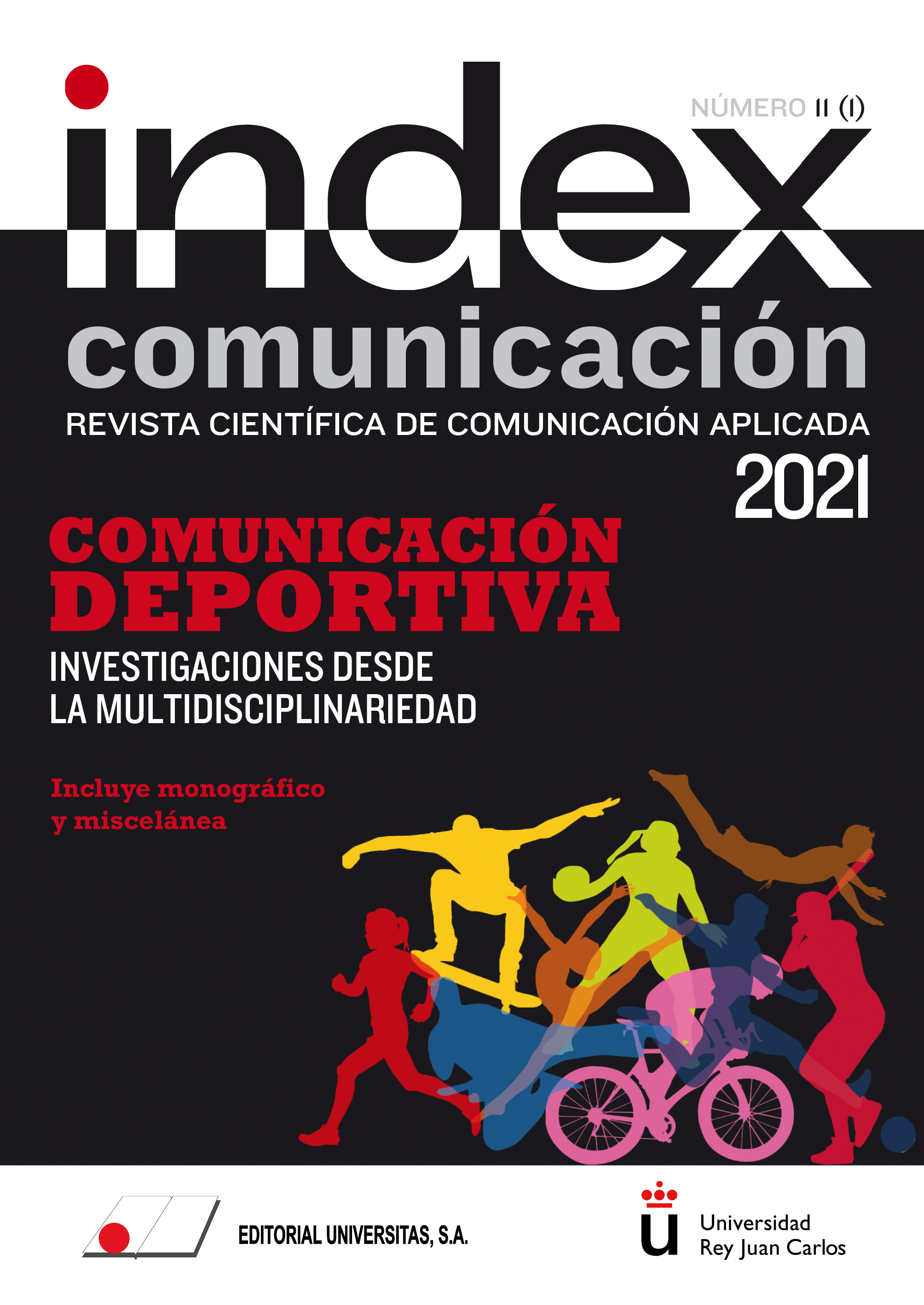Efficient Content on Social Media: promotion of Netflix Series
DOI:
https://doi.org/10.33732/ixc/11/01ContenKeywords:
Fiction series, Netflix, Social Media, Instagram, Twitter, Facebook.Abstract
Social media channels are frequently used by different audiovisual products when promoting content and generating conversations around their brands. In the case of fiction series broadcast by Netflix, the most widely used social media are Instagram, Facebook, and Twitter. This research aims atstablishing what the characteristics are of the content that, published on the profiles of said platforms by the accounts of these fiction series, generate greater efficiency and virality. To do this, we analyze the eight publications with the highest number of total interactions in a sample of series profiles to determine which platform, formats, types of content, hashtags, emojis or appealed values, among other factors, obtain better results in terms of the different types of interaction: likes, comments, and shares. The main results point to Instagram as the most efficient social network, where images are the content with the highest number of interactions. On Facebook and Twitter, however, videos get the highest efficiency and virality. For the rest of the analysis categories, we will find differences between the three platforms.
Metrics
References
BARLOVENTO COMUNICACIÓN (2020). OTT y Plataformas de pago en España. https://bit.ly/37oax0R
BERGANZA, R.M. y RUÍZ SAN ROMÁN, J.A. (2014). Investigar en Comunicación. Guía práctica de métodos y técnicas de investigación social en Comunicación. Madrid: McGraw-Hill.
BRADY, W.; WILLS, J.; JOST, J.; TUCKER, J. y VAN BAVEL, J. (2017). Emotion shapes the diffusion of moralized content in social networks. Proceedings of the National Academy of Sciences of the United States of America, 114(28), 7313-7318. https://doi.org/10.1073/pnas.1618923114
BRANDWATCH (2020). Informe sobre emociones 2020.
BUSCHOW, C.; SCHNEIDER, B. y UEBERHEIDE, S. (2014). Tweeting television: Exploring communication activities on Twitter while watching TV. Communications, 39(2), 129-149.
https://doi.org/10.1515/commun-2014-0009
DAMASIO, D. (2018). El error de Descartes. Barcelona: Destino.
EKMAN, P. (1999). Handbook of Cognition and Emotion. West Sussex: John Wiley & Sons Ltd.
EKMAN, P. (2003). El rostro de las emociones. Barcelona: RBA Libros.
FELDMAN, L.; LEWIS, M. y HAVILAND-JONES, J. (eds.) (2016). Handbook of emotions. Nueva York: The Guilford Press.
FERNÁNDEZ-GÓMEZ, E. y MARTÍN-QUEVEDO, J. (2018). La estrategia de engagement de Netflix España en Twitter. El profesional de la información, 27(6), 1292-1302. https://doi.org/10.3145/epi.2018.nov.12
FERNÁNDEZ-RÍOS, M. Y SÁNCHEZ, J. (1997). Eficacia organizacional: concepto desarrollo y evaluación. Madrid: Ediciones Díaz de Santos.
GARCÍA, D. y RIMÉ, B. (2019). Collective Emotions and Social Resilience in the Digital Traces After a Terrorist Attack. Psychological Science, 30(4), 617-628. https://doi.org/10.1177/0956797619831964
GONZÁLEZ-NEIRA, A. y QUINTAS-FROUFE, N. (2015). Revisión del concepto de televisión social y sus audiencias, en QUINTAS FROUFE, N. y GONZÁLEZ NEIRA, A. (coord.), La participación de la audiencia en la televisión: de la audiencia activa a la social. Madrid: AIMC. https://bit.ly/38AxBdd
GUERRERO-PICO, M. (2017). #Fringe, Audiences, and Fan Labor: Twitter Activism to Save a TV Show From Cancellation. International Journal of Communication, 11, 2071-2092. https://bit.ly/3mPbkxh
HABLEMOSDEEMPRESAS.COM (2018). Las lecciones que podemos aprender de Netflix en las redes sociales. Hablemosdeempresas.com. https://bit.ly/3mPTjyM
IAB (2018). Observatorio de marcas en redes sociales 2018.
IAB (2019). Observatorio de marcas en redes sociales 2019.
IAB (2020). Estudio de Redes Sociales 2020. https://bit.ly/3aIE88g
IAB, EPSILON y GESTAZIÓN (2020). Observatorio de Marcas en Redes Sociales 2020. https://bit.ly/3aHfrsR
IGARTUA, J.J. (2006). Métodos cuantitativos de investigación en Comunicación. Barcelona: Bosch.
NAVÍO-NAVARRO, M.; PUEBLA-MARTÍNEZ, B. y GONZÁLEZ-DÍEZ, L. (2018). Estrategias de social media marketing en las series de ficción: propuesta metodológica para determinar los factores de éxito, en V Congreso Internacional de metodologías en investigación de la comunicación. Facultad de Ciencias de la Información de la Universidad Complutense de Madrid, Madrid.
PÉREZ, L.; CARRERA, J. y GARCÍA, A.M. (2018). Eficacia como constructo multidimensional en la determinación de estrategias de informatización empresarial. Ingeniare. Revista chilena de ingeniería, 26(2), 354-369. http://dx.doi.org/10.4067/S0718-33052018000200354
PERIS, M.; MAGANTO, C. y KORTABARRIA, L. (2018). Escala de sentimientos y emociones en las redes sociales e internet (SERSI): Fiabilidad y validez. European Journal of investigation in health, psychology and education, 8(3), 143-155. https://doi.org/10.30552/ejihpe.v8i3.274
RAE (2020). Eficiencia. Diccionario de la lengua española, 23.ª ed., [versión 23.4 en línea]. https://bit.ly/37OrItV
RIFFE, D.; LACY, S. y FICO, F.G. (1998). Analyzing media messages: using quantitative content analysis in research. Mahwah-Nueva Jersey: Lawrence Erlbaum Associates.
RODRÍGUEZ MATEOS, D. y HERNÁNDEZ PÉREZ, T. (2015). Televisión social en series de ficción y nuevos roles del documentalista audiovisual. index.comunicación, 5(3), 95-120. https://bit.ly/38vZhzU
RUBIRA-GARCÍA, R.; PUEBLA-MARTÍNEZ, B. y GELADO-MARCOS, R. (2018). Social Representations in Studying Information, Knowledge and Mediations: A Critical Review. Social Sciences, 7(12), 256. https://doi.org/10.3390/socsci7120256
SAAVEDRA LLAMAS, M.; RODRÍGUEZ FERNÁNDEZ, L. y BARÓN DULCE, G. (2015). Audiencia social en España: Estrategias de éxito en la televisión nacional. ICONO14: Revista Científica De Comunicación Y Tecnologías Emergentes, 13(2), 214-237. https://doi.org/10.7195/ri14.v13i2.822
SERRANO PUCHE, N. (2016). Internet y emociones: nuevas tendencias en un campo de investigación emergente. Comunicar: Revista científica iberoamericana de comunicación y educación, 24(46), 19-26. https://doi.org/10.3916/C46-2016-02
WE ARE SOCIAL Y HOOTSUITE (2020). Digital 2020. Global Digital Overview. https://bit.ly/3aFbwwM
Published
How to Cite
Issue
Section
License
Copyright (c) 2021 Mariché Navío Navarro

This work is licensed under a Creative Commons Attribution-NonCommercial 4.0 International License.
Authors who submit to this journal agree to the following terms:
Authors retain copyright and ensure the magazine's right to be the first publication of the work as licensed under a Creative Commons Attribution-NoComercial 4.0 International License that allows others to share the work with an acknowledgment of authorship of the work and the initial publication in this magazine, with no commercial purpose.
Authors can establish separate additional agreements for non-exclusive distribution of the version of the work published in the magazine (for example, to an institutional repository or publish it in a book), with an acknowledgment of its initial publication in this journal.
It allows and authors are encouraged to disseminate their work electronically (eg, in institutional repositories or on their own website) prior to and during the submission process, as it can lead to productive exchanges, as well as a citation more early and most of the published work (See The Effect of Open Access).















